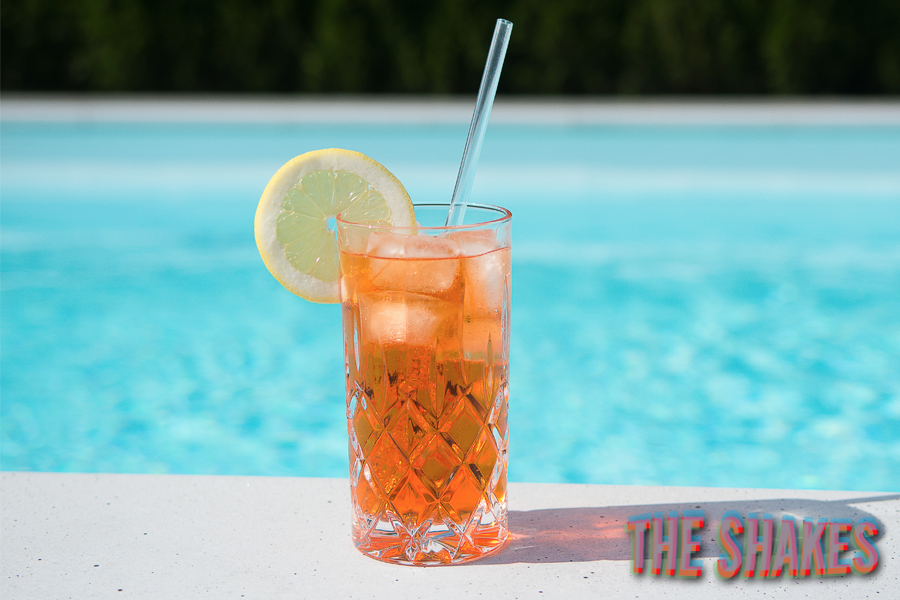As I confessed in our Fourth of July roundtable, I rarely (by which I mean never) drink beer. This is usually fine, as a bartender I have plenty of other alcoholic options at my fingertips. But where not being a beer drinker can get me in serious trouble is during the summer. Because we all know what summer means: Day drinking. And if you think you can sip gin and tonics all afternoon and remain standing while your friends split a case of Bud Light, you’re wrong. So very, very wrong.
Bud Light has 4.2 percent alcohol by volume (ABV) while that gin and tonic, assuming it’s poured in a bar that uses 1.5 ounces of 80-proof gin and 4 ounces of tonic, a fairly standard highball ratio, is 7.3 percent ABV. In other words, that gin and tonic is far stiffer than any watered-down domestic macrobrew. (Not to mention, Bud Light bottles are 12 ounces, a gin and tonic is under 6.)
Luckily, we’re living in the most interesting time for cocktails since Americans first started experimenting with mixing drinks (roughly 1860) and the end of Prohibition (exactly December 5, 1933). For the topic at hand, that means we now have at our fingertips a bunch of readily available liqueurs, infusions and fortified wines that make downright delicious low(er) ABV options for your summer BBQs and any other occasion you’d like to have a cocktail or two without passing out in the kiddie pool by 4 p.m. Namely…
Spritzes
In the U.S. the spritz was, for most of the 1980s and 1990s, relegated to high schoolers and a particular brand of white woman over 60. In Italy, though, spritzes (basically wine of some sort combined with ice and soda water) have been served with an added liqueur during cocktail hour for decades. There, the hour or so before dinner is known as aperitivo, the time at which people gather and have a few apéritif cocktails, or drinks built around light, appetite-stimulating liqueurs. Three of the more popular ones (either here or there): the Aperol Spritz (Aperol, sparkling wine and soda water); the Campari Spritz (Campari, sparkling wine and soda water); and the Americano Cocktail (Campari, sweet vermouth and soda water).
Each of them is a light, fizzy combination of sweet and bitter, kind of like drinking a lightly alcoholic soda. In fact, Moxie, a now-vintage, very New England variety of cola-ish soda, is made with gentian root, a flowering herb commonly used in European liqueurs that’s found in both Aperol and Campari. In addition to gentian, Aperol also contains cinchona (the herb that gives us quinine, both an anti-fever agent used in treating malaria and the bitter notes of tonic water), rhubarb and other herbs to make a slightly bitter, orange-flavored liqueur.
Aesthetically speaking, Aperol spritzes — 1.5 ounces of Aperol, ice, 2 ounces of sparkling white wine like cava or prosecco and a quick splash of soda water — are beautiful to behold. They’re a bright pink at the bottom, a light orange in the middle and a pale yellow at the top (before, that is, you swirl a straw through it). While Aperol clocks in at 11 percent ABV, an Aperol Spritz will carry about the same amount of alcohol as a glass of wine.
Campari, on the other hand, is a bright red, keenly bitter Italian aperitif that’s most often found paired with gin and sweet vermouth in a Negroni. It has a much higher ABV than Aperol, about 24 percent, although I’d say its bitterness will keep you from pounding Campari Spritzes too quickly. With notes of orange peel, and some say, fresh cut grass and a hint of baking spices, Campari can be difficult to describe without falling back on, “It tastes like Campari.”
The Americano Cocktail, however, is probably my favorite aperitif-related beverage: It’s a bit sweet, lightly tart and supremely easy drinking. To make one, combine equal parts (usually between an ounce and an ounce and a half) Campari and sweet vermouth, add ice and top with soda water. Toss a slice of orange on top, and you’re good to go.
This variation, because of the double-dose of liqueur, will be the highest ABV spritz of the trio, but it’s still much less potent than a standard mixed drink.
Vermouth
I once got into a heated exchange with a French bar guest who ordered, “Martini, please.” We spent probably three minutes going back-and-forth, with me repeating, “Alright, gin or vodka?” and her, thinking I didn’t understand, screaming “Martini!!!” into my face.
Turns out she wanted Martini & Rossi vermouth, on the rocks.
Vermouth is, essentially, a fortified wine: Wine, red or white, is infused with herbs and then combined with (or fortified by) a higher ABV alcohol like sherry, brandy, even vodka or rum, to increase the alcohol content and prevent spoilage. Most vermouths are bottled at 16 to 18 percent ABV (versus an unfortified wine, like the herb-infused bottle the vermouth-making process started with, which are typically between 9 and 14 percent ABV).
While ordering vermouth on its own in the U.S. was, until probably a few years ago, almost unheard of (hence my heated exchange with the French woman), vermouth on the rocks was the drink in Spain, where it was served on tap in nearly every corner store and bodega until about the mid-1970s. But after the death of Francisco Franco, the nationalist dictator who had ruled the country since 1939, the next generation of democratic Spaniards shunned the traditions of their parents and drinking vermouth fell out of favor.
But now, vermouth is back in a big way in Spain, and drinking fortified wines on their own, instead of, say, as a modifier to whiskey in a Manhattan, is popular in the U.S. today as well. And there are lots (I mean lots) to choose from. (My two personal favorites are probably Alessio Bianco, by Tempus Fugit spirits in California, and the Italian Cocchi Americano.)
While the traditional Spanish style of drinking vermouth is generally sweet vermouth on ice or dry vermouth over ice with an olive and a splash of soda, bianco vermouth (a sweet style white) on the rocks would be my recommendation. At about 32 proof each (16 percent ABV), drinking one — sometimes two if I’m really taking my time — leaves me with that nice, easy buzz you get after the first few sips of a full-proof cocktail.
Reverse Proportion Cocktails
A few months ago I had a woman sit down at my bar and order a Black Manhattan. This rang a bell somewhere in the back of my brain: Hmm, that’s, like, a vermouth-heavy Manhattan, right? Yeah, it has to be. No need to look it up, I’ll just flip the proportions! I asked if she preferred bourbon or rye, and when she said rye, I mixed 2¼ ounces of sweet vermouth with ¾ ounces Rittenhouse rye and served it on the rocks, as requested.
I should have looked it up.
A Black Manhattan actually calls for the standard 2¼ ounces of rye and ¾ ounce of Averna, a lower-proof amaro, instead of sweet vermouth. (She was very nice about it, and I fixed the drink.)
However, flipping the proportions on classic stirred cocktails like Manhattans and martinis is a common trick in bartender-land, particularly when we know we’re going to be out for a while, perhaps at an event, drinking for hours, surrounded by coworkers and/or big-shot industry names. (For example, for a reverse Manhattan, simply use 2¼ ounces of sweet vermouth and ¾ ounce whiskey; reverse Martinis work the same way, using three parts dry vermouth to one part vodka or gin.)
It’s a quick and easy way to lower the ABV of a drink whose ingredients you already know play well together — and more importantly, that you really enjoy.
You can mix up the proportions on shaken drinks, too: Daiquiris, sours and gimlets can all be made with ¾ ounces of alcohol and 1½ ounces of both citrus and sugar — the opposite of the normal booze-to-mixer ratio. Think lightly boozy lemonade or limeade that goes great over ice.
Realistically, the possibilities for lower-proof cocktails are endless. Some of them make more sense than others: I’m a big fan of the Sbagliato, which is reminiscent of a Negroni, but you couldn’t pay me to drink a Ferrari, equal parts Campari and Fernet Branca. But beyond your palate, they make the most sense when you expect to do some serious day drinking.
Trust me on this one: There’s a reason I don’t bring gin to summer afternoon gatherings anymore.

